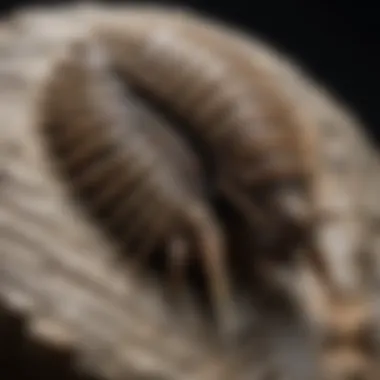Exploring Fossil Canada: A Guide for Collectors


Intro
Fossil collecting in Canada presents a unique opportunity to engage with the planet's distant past. Canada boasts a diverse array of geological formations, spanning various eras. This richness of geological history translates into an equally diverse fossil record. Collectors, whether novice or experienced, can find immense value in understanding the processes that shape these remnants of life. Grasping key aspects, such as rock and fossil identification, collection methods, and preservation techniques, is essential for any fossil enthusiast.
Rock and Fossil Identification
Identifying rocks and fossils forms the foundation of successful collecting. Understanding the different types of rocks—igneous, sedimentary, and metamorphic—helps in locating fossils within them. Fossils, on the other hand, can vary significantly. They may include:
- Body fossils (like bones or teeth)
- Trace fossils (such as footprints or burrows)
- Microfossils (tiny remains seen under a microscope)
When identifying a fossil, consider its characteristics:
- Texture: Rough or smooth surfaces can indicate different ages and environments.
- Color: Certain hues may suggest specific types of minerals involved in fossilization.
- Shape: Unique shapes can often signify particular species or types of organisms.
To aid in identification, collectors should use tools like a magnifying glass, field guides, and geological maps. Such resources can provide clarity and enhance the enjoyment of fossil hunting.
Collecting Tips and Techniques
When it comes to collecting fossils, best practices ensure respect for the environment and legal regulations. Always seek permission from landowners before collecting. Additionally, it is vital to check local laws regarding fossil collection, as some places may have restrictions.
To locate prime collecting sites, consider areas with known fossil deposits. Major provinces like Alberta and British Columbia offer rich grounds, particularly in locations like Dinosaur Provincial Park or the Peace River area.
To safely extract specimens, follow these steps:
- Research the site beforehand to understand what to expect.
- Use proper tools: A small hammer, chisels, and brushes can be effective.
- Dig gently: Avoid using excessive force that may damage the fossil.
- Wrap and label specimens immediately to preserve context.
Preservation and Display
Preserving and displaying fossils requires care to protect these treasures. Simple techniques can go a long way:
- Apply consolidants to strengthen fragile fossils.
- Store specimens in acid-free containers to prevent degradation.
Proper storage methods include:
- Keeping fossils in a climate-controlled environment.
- Avoiding direct sunlight, which can fade colors.
For display, think creatively. Items can be showcased in:
- Shadow boxes that provide depth and protection.
- Glass cases that showcase details while keeping dust away.
Geological Insights
An understanding of the geological processes influencing fossil formation provides collectors with greater insight. Canada’s varied geological formations, such as the Rocky Mountains, endow the landscape with an abundant fossil record.
These formations developed over millions of years through:
- Sedimentation: Layers of sediment build over time, encapsulating organic material.
- Tectonic activity: Movements cause shifts that can expose fossils.
Historically, notable discoveries—like the Alberta dinosaurs—have significantly advanced paleontology. Each find adds to the intricate story of our planet's life and its evolution.
Important Note: Fossils serve as critical records not just for paleontologists but for understanding environmental changes over time.
This comprehensive guide for collectors aims to deepen understanding and appreciation of fossils within the Canadian context.
Prelude to Fossil Canada
Fossils play a crucial role in understanding Earth's history. Fossil Canada offers a unique insight into the geological records formed over millions of years. This section highlights the significance of studying fossils in Canada, particularly as it relates to collectors and enthusiasts.
Tracing the origins and types of fossils found in Canada allows collectors to appreciate the vastness of the geological landscape. Canada has a diverse range of fossil deposits, varying from the Arctic to the plains of Alberta. Each of these areas presents different historical contexts and fossil types.
Understanding Fossils
Fossils are preserved remains or traces of ancient life. They can be found in various forms, including body fossils like bones and shells, as well as trace fossils such as footprints and burrows. These remnants tell stories about the organisms that existed millions of years ago. Understanding fossils involves more than just recognizing their physical forms. It also includes learning about the conditions that led to their formation.
Critical factors influencing fossilization include burial in sediment, mineral replacement, and the absence of oxygen. These processes help preserve organic material over geological time scales, allowing modern-day collectors to discover ancient life forms in the present. Knowledge of these elements enhances collectors' ability to identify significant fossil sites.
Importance of Fossils in Geology
Fossils serve as essential clues in the field of geology. They help geologists to reconstruct past environments and understand the chronological sequence of events in Earth's history. The presence of certain fossils can indicate the age of rock layers, contributing to the development of geological time scales.
Additionally, fossils allow for the study of evolutionary processes. By examining transitional fossils, researchers can trace the development of species over time. This has profound implications for our understanding of biodiversity. Moreover, fossils can provide insights into ancient climates, helping scientists analyze how ecosystems responded to changes in the Earth's conditions.
Fossils provide a window into the Earth's distant past, illustrating the connection between life and its environment.
In summary, understanding fossils and their geological importance equips collectors with a deeper appreciation of the natural history of Canada. This knowledge fosters a greater connection to the processes that have shaped our planet.
Geological History of Canada


Understanding the geological history of Canada is crucial for fossil collectors and enthusiasts alike. This rich history is not only a record of the Earth's past but also shapes the places where fossils can be found. By exploring the geological history, collectors can better appreciate the origins of the fossils they seek. The rock formations, sediment deposits, and tectonic events that have occurred over millions of years are the key to unlocking the secrets held within the Earth.
Formation of Geological Strata
The formation of geological strata involves layers of Earth that develop over time as sediments settle from water or air. In Canada, various processes like erosion, volcanic activity, and sedimentation have contributed to this stratification. For example, regions like the western mountains display sedimentary rock layers that tell a story of ancient seas and environments.
These layers vary in age, composition, and fossil content. Each stratum holds unique fossils that reflect different ecological conditions. Understanding these formations can help collectors predict where specific types of fossils might be located.
- Sedimentary layers often preserve more fossils than igneous or metamorphic rocks.
- The accentuation of certain conditions, like volcanic eruptions, can result in rich fossil beds, worth exploring for collectors.
Consideration of geological strata also highlights the importance of fieldwork. Collectors must identify the strata in their search areas to maximize their chances of finding fossils.
Key Geological Periods
Throughout its history, Canada has experienced several key geological periods, each contributing to the country's diverse fossil record. Here are significant periods:
- Cambrian Period 541–485 million years ago: This period is known for the Cambrian Explosion, a time when a vast number of life forms appeared. The Burgess Shale, a significant fossil site, originates from this era, harboring remarkably preserved marine organisms.
- Ordovician Period 485–444 million years ago: During this time, marine life flourished. Many invertebrate fossils, such as trilobites, were formed, which can still be found in rock formations today.
- Devonian Period 419–359 million years ago: Often referred to as the “Age of Fishes,” fossils from this period include early sharks and bony fish. The sediments from this period can offer a rich fin-draw of cartilaginous and bony fish remains.
- Cretaceous Period 145–66 million years ago: The last of the dinosaur ages, this era produced a wealth of vertebrate fossils, including those of great dinosaurs like Tyrannosaurus rex. Dinosaur Provincial Park is a prominent site from this time.
Overall, each geological period gives context to the fossils found in Canada.
"Knowledge of geological periods not only enhances collecting strategies but also enriches the overall appreciation of the fossil record."
Awareness of the geological history and the formation of strata empowers collectors and researchers. This foundational knowledge brings clarity to the fossil discovery journey. It transforms collecting from mere hobby into a meaningful pursuit in understanding Earth's vast history.
Prominent Fossil Sites in Canada
Fossil sites across Canada serve as invaluable resources for collectors and researchers alike. They offer rich insights into prehistoric life and geological history. Each site presents unique opportunities for discovery, learning, and connection to the past. Collectors ought to approach these locations with care and respect, understanding their significance in paleontology.
The Burgess Shale
The Burgess Shale is one of the most famous fossil sites in the world. Located in the Canadian Rockies of British Columbia, it dates back roughly 508 million years to the Cambrian period. What makes the Burgess Shale unique is its well-preserved soft-bodied organisms. These include early ancestors of modern animals, which give crucial insights into the evolution of life on Earth.
Visitors can find detailed fossils of creatures such as Marrella and Anomalocaris. Excavation for collection here is regulated strictly to preserve the site's integrity. Collectors must obtain permits and follow guidelines to minimize environmental impact. The site is accessible through guided tours, providing educational context and expertise for collectors interested in invertebrate fossils.
"The fossil diversity found in the Burgess Shale offers a glimpse into a world that existed long before the dinosaurs."
Dinosaur Provincial Park
Dinosaur Provincial Park in Alberta is a UNESCO World Heritage site, renowned for its extensive dinosaur fossils. The area has yielded more dinosaur specimens than any other Canadian site. This park features fossils from over 40 different species, including the iconic Albertosaurus and Hadrosaurus.
The geological formations are of the Late Cretaceous period, which allows collectors to find well-preserved remains in situ. The park offers workshops and field trips where guided experts assist enthusiasts in excavating fossils properly. It is essential to respect the regulations regarding fossil collection to support conservation efforts.
The Manitoba Immigrants
In Manitoba, the term 'Manitoba Immigrants' often refers to significant fossil discoveries made in the region. The site is known for its diversity of plant and animal fossils from the Paleozoic and Mesozoic eras. Fossils of plants, fish, and insects can be found in various sedimentary rocks.
Amateur collectors often visit Manitoba to unearth fossils, especially in areas like the Interlake region. It is crucial for them to familiarize themselves with the specifics of fossil laws in Manitoba, ensuring ethical collecting practices. Local communities sometimes organize field days, promoting both collection and conservation.
Collecting fossils from these prominent sites enhances understanding of geological history and paleontological diversity in Canada. Each location offers a unique glimpse into the past and connects collectors with the broader narrative of life on Earth.
Fossil Types and Their Significance
Understanding the various types of fossils and their significance enriches the study of paleontology. Fossils are not merely remnants of ancient life but are crucial in piecing together our planet's history. By categorizing fossils into specific groups, such as invertebrates, vertebrates, and plants, collectors gain deeper insights into the biodiversity of past ecosystems. Each fossil type tells a distinct story about its environment and the conditions under which it was formed. The study of these types allows researchers to understand evolutionary processes and climatic changes over geological time scales.
Invertebrate Fossils
Invertebrate fossils make up a large portion of the fossil record. They include organisms without a backbone, such as mollusks, arthropods, and echinoderms. The significance of invertebrate fossils lies in their abundance and diversity, providing a wealth of information about ancient marine environments. Collectors often seek these fossils due to their intricate shapes and varied forms.
Invertebrate fossils can indicate paleoenvironmental conditions. For example, the presence of certain shell types can suggest if the region was once a shallow sea or a freshwater environment. Key examples of invertebrates from Canadian sites include ammonites and trilobites. These fossils aid in stratigraphy, which is the study of rock layers and layering, offering crucial context to geologists.
Vertebrate Fossils
Vertebrate fossils, which include remains of animals with backbones, play a vital role in understanding the evolution of life on Earth. These fossils include not only dinosaurs but also ancient fish, amphibians, and mammals. The significance of vertebrate fossils is particularly pronounced in the context of dinosaur provincial parks in Canada, where fossils showcase a remarkable diversity of these creatures during the late Cretaceous period.
The fossilization process of vertebrates often results in more recognizable remains, such as bones and teeth, which can reveal much about the organism's diet, behavior, and habitat. By studying these fossils, researchers and collectors can reconstruct ancient ecosystems and gain insights into how vertebrate life evolved and adapted over time.
Plant Fossils
Plant fossils may not capture that attention as their animal counterparts but hold a significant place in paleontology. These fossils provide vital information about ancient climates, geological history, and ecosystems. Plant fossils include leaves, roots, and pollen from various species, reflecting the vegetation that thrived during specific geological periods.
They indicate changes in Earth's climate, and their presence can inform about the ecological conditions of the time. For instance, the discovery of specific plant remains can suggest a warm and humid climate, while others might indicate drier conditions. Collecting plant fossils aids in reconstructing the flora of ancient landscapes, helping researchers and enthusiasts understand the continuity and change of plant life through the ages.
Understanding the significance of different fossil types enhances the collector's ability to interpret geological and biological history.
In summary, the study of invertebrate, vertebrate, and plant fossils has profound implications for understanding our planet's past. Each type plays a unique role, helping reconstruct ecological dynamics and the evolution of life forms over millions of years. By collecting and studying these fossils, one not only enriches their personal collection but also contributes to the broader scope of paleontological knowledge.
Collecting Fossils: A Practical Guide


Collecting fossils is more than just a hobby; it is a window into the past, a way to connect with ancient life forms. For many enthusiasts, fossil collecting provides both excitement and education. This section will highlight key aspects of the collecting process, from preparation to legal concerns, ensuring a comprehensive understanding for both novice and experienced collectors.
Preparation and Planning
Before embarking on a fossil collection adventure, proper preparation is crucial. Knowing where to go and what to look for can enhance the experience significantly. Here are some important points to consider:
- Research Locations: Identify potential fossil sites. Research local geological formations. Sites such as the Burgess Shale and Dinosaur Provincial Park are well-known, but lesser-known areas may hold treasures too.
- Set Goals: Clearly define what you want to collect. Focus on specific types of fossils, such as invertebrates or plant fossils. This will keep you focused during your hunt.
- Check the Weather: Good weather can make a big difference to your trip. Always plan for the conditions to make your collecting more enjoyable.
Planning also involves logistics. Ensure that you have enough time set aside for your trip, and consider whether you need permits or need to check with landowners.
Essential Tools for Collectors
The right tools can make fossil collecting easier and more effective. Some tools are essential, while others can enhance your experience:
- Hammer and Chisel: A sturdy rock hammer is vital for breaking into hard rock layers. A chisel will help shape or extract specimens.
- Safety Goggles: Protecting your eyes is important when breaking rock. Always wear safety glasses.
- Brush: A paintbrush can help clean dirt off fossils without damaging them.
- Field Notebook: Keeping a notebook can help you track your findings and locations, adding valuable context to your collection.
- Backpack: A good-quality backpack will carry your tools and any fossils you collect.
Each of these tools plays a role in safely and efficiently collecting fossils.
Legal Considerations in Fossil Collection
Fossil collection is not just about adventure; it also comes with legal responsibilities. Understanding the legal landscape is essential before you start:
- Permits: In certain locations, you might need specific permits to collect fossils. Always check local regulations. Whether in national parks or private land, rules vary.
- Collecting Limits: Many sites have restrictions on how many fossils you can collect. It’s prudent to know these limits to avoid fines or legal trouble.
- Respect for Nature: Collect responsibly. Avoid damaging the environment. Leave sites as you found them to preserve the area for future collectors.
Protecting fossil sites is vital for maintaining Earth's history for future generations.
Awareness about these legal aspects can help you enjoy fossil collecting while being a good steward of natural resources.
Preserving Fossils After Collection
Preserving fossils after collection is a crucial aspect for any collector. It ensures that the delicate structures remain intact for future study, display, and enjoyment. Proper preservation techniques protect fossils from environmental damage, degradation, and contamination. As these relics of the past provide invaluable insight into the history of life on Earth, their preservation is not just a responsibility but also an obligation toward science and education.
Cleaning Techniques
Cleaning fossils requires a careful approach to avoid damaging them. The first step is to remove excess dirt and debris, which may be done by gently brushing with a soft bristle brush. Avoid using harsh chemicals or abrasive materials that could scratch the fossil. For embedded materials, using water can help soften dirt. If further cleaning is necessary, specialized tools like dental picks can be employed, but one should always work cautiously.
Some collectors find ultrasonic cleaners useful. These devices use high-frequency sound waves in a liquid to agitate dirt off the surface. However, the effectiveness and safety can vary depending on the fossil type.
Best Practices for Cleaning:
- Always assess the fossil before choosing a cleaning method.
- Test cleaning methods on less valuable pieces first.
- Work slowly and methodically to ensure all parts are treated gently.
Storage Solutions
Effective storage solutions are essential to protect fossils from physical damage and environmental factors. Fossils should be stored in a controlled environment, free from excessive moisture, temperature fluctuations, and sunlight. Using acid-free materials is recommended to avoid any chemical reactions that could lead to deterioration. Clear plastic boxes or archival trays can serve as excellent storage options.
Labeling each fossil with essential information such as the date of gathering, location, and any other relevant data is also beneficial. This detailed tracking is vital for future reference and helps in academic and personal studies. Avoid placing heavy items on top of fossils, as this could lead to cracks or breaks.
Storage Tips:
- Use climate-controlled environments when possible.
- Avoid cardboard boxes with inks that could transfer components.
- Regularly check conditions of the storage area, looking for signs of moisture or pest issues.
Displaying Fossils Safely
When it comes to displaying fossils, safety is a priority. Ensure that displays do not expose fossils to direct sunlight, which can lead to discoloration and fragility over time. Boxes with glass panels can provide visibility while shielding fossils from dust and light.
Mounting fossils securely is essential; many collectors prefer using clear acrylic stands that do not distract from the fossil itself. When showcasing fossils in homes or offices, always consider their placement. High humidity or high traffic areas should be avoided to minimize exposure to potential risks.
"A well-preserved fossil can tell a story that might otherwise be lost to time."
Display Recommendations:
- Choose display cases that offer UV protection.
- Keep display areas clean and dust-free.
- Limit the number of people who can access the display to reduce the risk of accidental damage.
By investing time and care into cleaning, storage, and display methods, collectors can ensure that their fossil collections endure through the ages, enriching future generations with the wonderful stories of our planet's history.
The Role of Technology in Paleontology
Technology has transformed the field of paleontology, creating new methodologies that enhance our understanding of fossils and the environments in which they were formed. Advancements in tools and techniques make it possible to explore fossil sites more efficiently and to analyze finds with greater precision. This section discusses the significance of technological developments that are shaping the future of fossil collection and research.
Remote Sensing Techniques
Remote sensing involves the collection of data from a distance, often using satellite imagery or aerial photography. This technique plays a pivotal role in paleontological research by allowing scientists to identify potential fossil sites without extensive ground surveys.
- Advantages: Remote sensing offers numerous benefits, such as:
- Cost-Effectiveness: It reduces the need for manpower and reduces the time spent in the field.
- Access: Hard-to-reach areas can be explored without the risks associated with physical excavation.
- Data Accumulation: Scientists can gather historical data regarding land use and geological changes over time, which aids in understanding fossil formations.


However, this technique does have its limitations. The accuracy of remote sensing can vary depending on factors such as weather conditions and the type of vegetation present in an area.
3D Printing in Fossil Reconstruction
3D printing is another remarkable development that enhances the study of fossils. This technology allows for the creation of precise replicas of fossils, which can be used in various ways.
- Applications:
- Education and Display: Museums can use 3D-printed fossils as replicas for educational purposes, enabling visitors to interact with quality representations without risking damage to original specimens.
- Research: Scientists can manipulate 3D-printed models to study anatomy, behavior, and ecological relationships of extinct species.
- Restoration: Missing parts of fossils can be reconstructed digitally, and then printed, filling in gaps and providing a more complete picture of the specimen.
3D printing in paleontology is not without challenges. The need for high-quality imaging and modeling software is essential for producing accurate prints. Costs can also be a consideration for smaller institutions.
The integration of technology in paleontology not only enriches the discipline but also ensures that research becomes more accessible to a broader audience.
In summary, technology plays a critical role in paleontology by improving data collection methods and providing innovative tools for research. Remote sensing and 3D printing are just two examples of how technological advancements are evolving the field and enhancing our understanding of ancient life.
Educational Resources for Fossil Collectors
Understanding fossils and paleontology requires access to accurate and comprehensive educational materials. For collectors, both novice and experienced, educational resources are crucial for enhancing their knowledge and skills. This section covers important resources that will assist in the journey of fossil collecting.
Books and Field Guides
Books and field guides serve as foundational tools for fossil collectors. They provide essential information on various fossil types, collection techniques, and geological contexts. Titles such as Fossils: A Very Short Introduction and Field Guide to the Fossils of North America are particularly useful. These resources offer detailed descriptions, imagery, and identification tips that aid in distinguishing between fossil types.
- Specific Elements: Collectors can use these guides to gain insight into local geology and fossil expectations. They often include maps showing where specific fossils can be found.
- Benefits: Knowledge derived from reading can lead to more successful and informed fossil hunts. This knowledge can also prevent potential mishaps related to illegal collection practices.
- Considerations: When selecting books, it's important to ensure the information is current. Older books might lack updated research and discoveries, which can mislead collectors.
Online Databases and Communities
The digital age offers a wealth of resources for fossil collectors. Online databases provide access to extensive collections of fossil records, facilitating research and study. Websites such as the Paleobiology Database and research databases from universities can be invaluable.
- Specific Elements: These databases often include photographs and descriptions of fossil finds from across Canada, thus helping collectors identify their discoveries.
- Benefits: The ability to connect with online communities strengthens the collector's network. Forums on platforms such as Reddit and Facebook allow for interaction with fellow enthusiasts, exchange of experiences, and sharing of knowledge.
- Considerations: As with any online resource, verifying the credibility of online information is critical. Engaging with reputable sources and experts is advisable to ensure accurate and useful information.
"Engaging with educational resources improves a collector’s ability to both collect and understand fossils better, ultimately enriching their overall experience."
By integrating books, field guides, online databases, and community interactions into their exploration, fossil collectors can significantly enhance their understanding and overall experience in the field.
The Future of Fossil Collection and Research
The future of fossil collection and research offers a unique lens through which collectors and enthusiasts can appreciate ongoing developments in paleontology. As we consider the dynamics of fossil discovery and preservation, it’s clear that environmental stewardship and conservation efforts are critical. Understanding these elements paves the way for more responsible collection practices and greater public interest in paleontological research.
Environmental Considerations
Tackling environmental considerations is paramount in ensuring sustainable practices in fossil collection. The impacts of climate change are palpable, and their effects on fossil sites are becoming increasingly apparent. Erosion, changing weather patterns, and habitat destruction threaten the geological formations that harbor fossils.
Collectors must adopt a mindset of responsibility. This means choosing locations that are not endangered and practicing minimum-impact collecting. Collecting only in designated areas during allowable times can help protect vulnerable sites. Additionally, it is crucial to be aware of the surrounding ecosystem. Fossil collection should not disrupt local flora and fauna, as they play significant roles in maintaining environmental balance.
Key strategies include:
- Educating oneself about local ecosystems and geology.
- Utilizing technology, like satellite imagery, to assess sites and minimize human impact.
By integrating awareness into fossil collection practices, collectors contribute positively to the future of paleontological research and environmental health.
Conservation Efforts
Conservation efforts are essential in preserving the rich fossil heritage of Canada. Organizations and institutions dedicated to paleontology play a significant role in safeguarding these natural resources. They establish protocols and guidelines to ensure that fossil collection is conducted ethically and sustainably.
Community engagement is also a vital part of these efforts. Local communities often possess invaluable knowledge about historical sites and fossil-rich areas. Involving them in conservation initiatives fosters a culture of preservation and respect for geological heritage.
Consider these actions that strengthen conservation efforts:
- Participating in educational workshops held by local museums or universities.
- Supporting non-profit organizations focused on geological preservation through donations or volunteer work.
- Advocating for legislation aimed at protecting important fossil sites from commercial exploitation.
The collaborative efforts between researchers, collectors, and communities contribute to a future where fossils are not only collected but also cherished and protected.
"The mysteries locked in fossils should not only be explored but preserved for future generations to retrieve and study."
As the field of paleontology evolves, integrating responsible collection and conservation practices will become ever more critical. Embracing these principles ensures that the enthralling narratives of our planet's past remain intact for the benefit of future collectors and researchers.
Epilogue
The conclusion serves as a significant element in this article, encapsulating the key insights and themes explored throughout. It synthesizes the vast array of information presented, ensuring that readers can recall and reflect upon the most critical aspects of fossil collection and appreciation in Canada.
Summary of Key Points
To summarize, the journey through Fossil Canada has uncovered several essential points:
- The geological history of Canada plays a foundational role in the formation of a diverse array of fossils. Each geological period has contributed uniquely to the fossil record, making Canada a haven for collectors.
- Notable fossil sites such as the Burgess Shale and Dinosaur Provincial Park provide rich locations for both amateur and experienced fossil hunters, offering access to significant specimens.
- Understanding the different types of fossils—ranging from invertebrates to vertebrates and plant fossils—allows collectors to appreciate the evolutionary stories these remnants represent.
- Practical advice regarding the collection process emphasizes preparation, the right tools, and legal considerations which are critical for ethical collecting practices.
- Preservation techniques help ensure that collected fossils maintain their integrity over time, allowing future generations to study and appreciate these historical treasures.
- Technology has revolutionized paleontology, enhancing research and reconstruction, and promising exciting developments in the field of fossil studies.
- Educational resources empower collectors to expand their knowledge, making fossil collecting not just a hobby, but a lifelong learning experience.
Encouraging Continued Exploration
Encouraging readers to pursue further exploration is vital. Fossil collecting is not merely about acquiring specimens; it is about engaging with the earth’s history and contributing to scientific knowledge.
- Stay Curious: Always seek to learn more about geological formations and the fossils specific to different regions of Canada. Knowledge about local ecosystems and historical climates can enrich the collecting experience.
- Participate in Community Events: Local museums, universities, and paleontological societies often host events and workshops. Joining these initiatives can provide hands-on experience and connect collectors with experts in the field.
- Contribute to Conservation Efforts: As collectors pursue their interests, they must also consider the environmental impact of fossil collection. Engaging in conservation initiatives helps protect fossil sites for future study and enjoyment.
By embracing a mindset of continuous exploration and education, collectors can significantly enhance their understanding and appreciation of fossils and their importance in the context of Canadian natural history.







